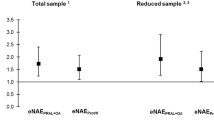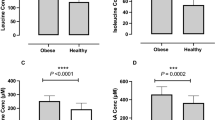Abstract
Objective: We have measured urea kinetics in normal adult men and women of different body composition to determine whether adiposity is associated with differences in the rate of urea production or endogenous urea hydrolysis.
Design: Urea kinetics were determined from the excretion of [15N15N]urea in urine over a period of 48 h following a single oral dose of [15N15N]urea, in nine lean and nine obese women and in seven light and seven heavy males while they were consuming their habitual diets. Urinary 5-L-oxoproline was measured as an index of glycine metabolic status.
Setting: The studies were carried out in the research ward of the Tropical Metabolism Research Unit, University of the West Indies.
Results: Successful studies were completed in eight obese and five lean women and in six heavy and five light men. When compared with lean women, in obese women the rate of urea production and hydrolysis was significantly greater and this difference could not be accounted for by the greater fat-free mass alone, and was in part associated directly with the increase in fat mass. The rate of urea production and hydrolysis was greater in heavy men than in light men, a difference which was attributed to an increase in dietary protein. In obese women and heavy men there was a significantly higher rate of excretion of 5-L-oxoproline in urine when compared with lean women and lean men respectively.
Conclusion: This paper highlights the difficulty in identifying an appropriate reference with which to express results in people of different body composition. In obese women urea production and the hydrolysis of urea are increased, in part related to the increased fat-free mass, but also related to the increased fat mass itself. In obese women and men on high protein diets the greater rate of hydrolysis urea may be a reflection of an increased demand for the synthesis of non-essential amino acids, especially glycine.
Sponsors: This work was carried out as a part of an elective study period of SCC, which was supported by the Wellcome Trust, Cow and Gate/Nutricia and Lederle. We acknowledge support from BBSRC and the Wessex Medical Trust.
This is a preview of subscription content, access via your institution
Access options
Subscribe to this journal
Receive 12 print issues and online access
$259.00 per year
only $21.58 per issue
Buy this article
- Purchase on Springer Link
- Instant access to full article PDF
Prices may be subject to local taxes which are calculated during checkout
Similar content being viewed by others
Author information
Authors and Affiliations
Rights and permissions
About this article
Cite this article
Child, S., Soares, M., Reid, M. et al. Urea kinetics varies in Jamaican women and men in relation to adiposity, lean body mass and protein intake. Eur J Clin Nutr 51, 107–115 (1997). https://doi.org/10.1038/sj.ejcn.1600373
Received:
Revised:
Accepted:
Issue Date:
DOI: https://doi.org/10.1038/sj.ejcn.1600373



